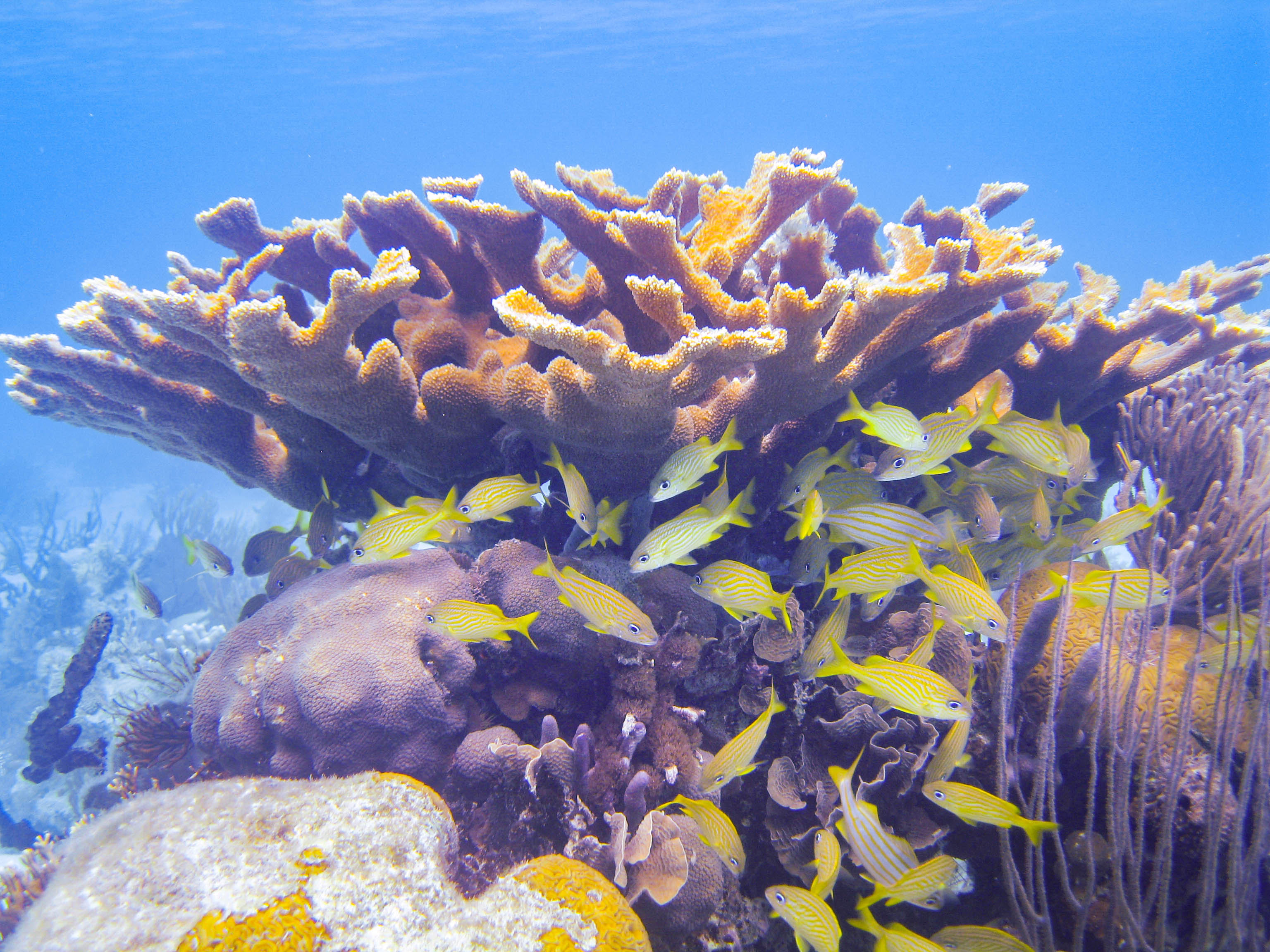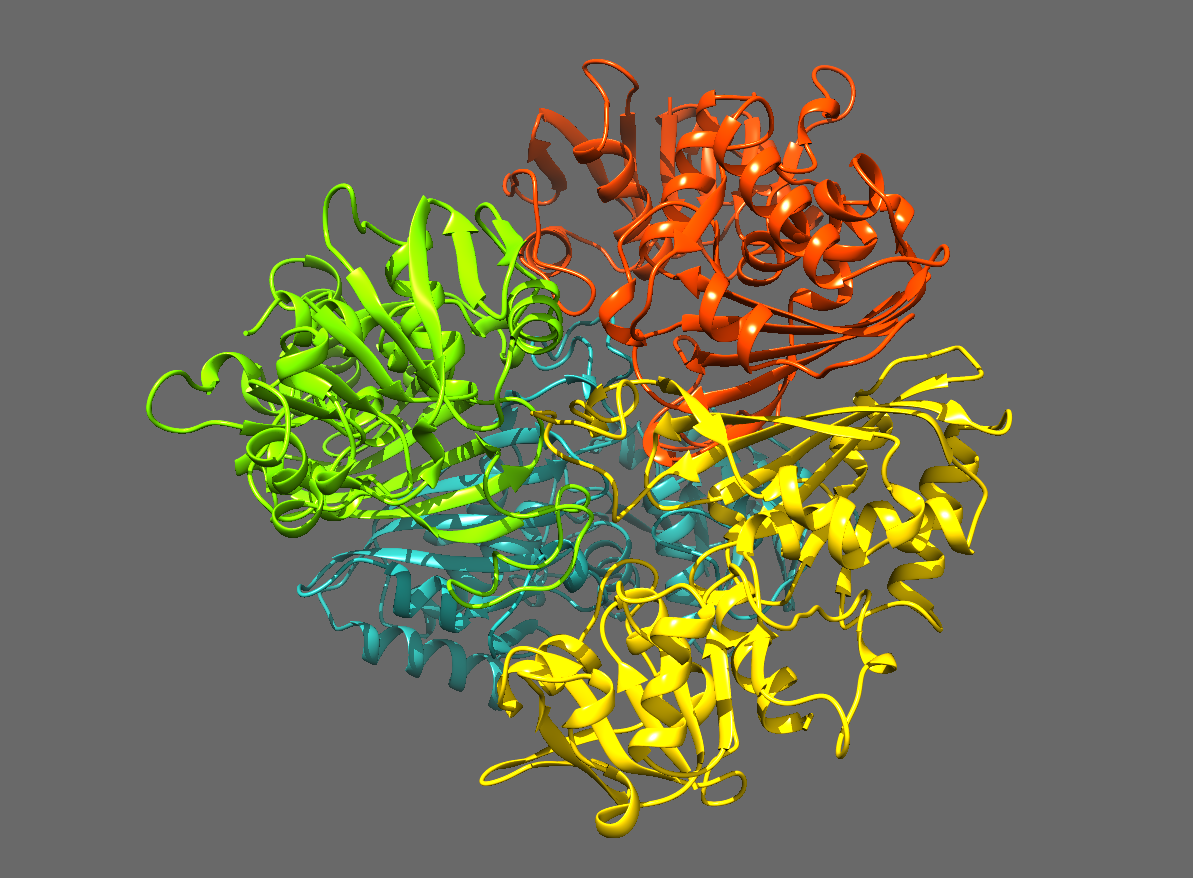Peter A FieldsThe Dr. E. Paul & Frances H. Reiff Professor of Biology
Education
B.A.S., 1987, Biological Sciences and Anthropology, Stanford University
M.S., 1987, Biological Sciences, Stanford University
Ph.D., 1995, Marine Biology, Scripps Institution of Oceanography (U.C. San Diego)
Postdoctoral Fellow, 1995 - 2001, Hopkins Marine Station of Stanford Unversity
Research
We are focusing on two main areas of research in the Fields lab currently -- the biochemical origins of coral bleaching, and molecular dynamics simulations to describe the effect of environmental stresses on protein function. Both are described
in more detail below.
If you are an F&M student, and you are interested in the interface between biochemistry
and marine biology, I would love to talk with you about research opportunities in
my lab!
1. Coral Bleaching and Biochemical Temperature Adaptation

The work in our lab focuses on biochemical adaptations of marine organisms to extreme
environments. Over the past several years, my students and I have focused on the
relationship between tropical corals and their algal symbionts, exploring potential
biochemical causes of coral bleaching, a devastating phenomenon that is harming reefs
at an ever increasing rate. Reef-building corals throughout the tropical oceans depend
on a relationship with single-celled algae (Symbiodiniaceae) that live within coral tissue and that provide the coral most of its energy. However,
during times of environmental stress, and especially high temperature, corals expel
these algal symbionts, a process termed "coral bleaching." Unfortunatley, bleaching
often leads to the death of the coral and damage to the reef. In fact, many scientists
are concerned that much of the Earth's coral reef habitat will be lost in the next
fifty years due to the impacts of ocean warming and coral bleaching. Through work
in our lab, we are aiming to extend our understanding of why bleaching occurs, by
comparing the temperature sensitivity of important enzymes in corals to those of different
types of Symbiodiniaceae.
In our current project we are testing two specific hypotheses: First, that there is a mismatch in adaptation temperature between the corals and the algae, leading to a loss of metabolic function in Symbiodiniaceae at higher temperatures. To test this hypothesis, my students and I are recombinantly
expressing metabolic enzymes of both corals and Symbiodinium, and measuring molecular thermal stability and temperature sensitivity of enzyme
function. A second hypothesis is that Symbiodiniaceae types differing in thermal tolerance are biochemically adapted to different temperatures. Researchers have shown that different clades (kind of like species) of Symbiodiniaceae have varying thermal sensitivities, providing the coral-algae symbiosis different
levels of resistance to heat-induced bleaching. We are testing this second hypothesis
by examining enzymes from different Symbiodiniaceae types. In addition, because Symbiodiniaceae orthologs are structurally similar, we are creating 3D models of our study enzymes
and examining them to determine the extent, location, and types of amino acid substitutions
that lead to changes in thermal sensitivity. We hope that the results of the study
will help researchers better predict the likely extent of future bleaching events,
and the possibility that corals and algae may be able to adapt to withstand increasing
water temperatures.
2. Molecular Dynamics Simulations
Molecular dynamics simulations (MDS) is a group of computational methods to determine
the movement through space of a large number of particles over time. Specifically,
we calculate the trajectories of atoms in protein molecules, to determine how the
molecules flex and change conformation under different conditions. Flexibility is
a key trait of proteins, and is necessary to allow functions like catalysis that require
changes in protein shape during binding of substrate or release of product. However,
at the same time proteins must maintain enough stability so that they do not unfold
(denature) in response to the kinetic energy of the solvent and solute molecules around
them. Thus, proteins maintain a balancing act that can be perturbed by changes in
temperature, pressure, salinity, and especially mutations that lead to changes in
packing or non-covalent bonding in the polypeptide.
We use an MDS package called VMD/NAMD, run in Linux workstations, to study how enzymes
from marine organisms are affected by environmental stress. We have employed this
approach to describe how enzymes from coral and their symbiotic algae are affected by high temperatures (the coral enzymes seem to handle the stress better!),
and how enzymes from fish adapted to Antarctic waters are able to function in an environment with such low temperatures. Because our simulation
questions are limited only by the availability of gene sequences and 3D protein structures
in online databases (as well as computing power), we can use MDS to address an amazingly
wide variety of questions regarding biochemical adaptation.
Publications
Selected Publications (* denotes undergraduate author)
Perez, AM*, Wolfe, JA*, Schermerhorn, JT*, Qian, Y*, Cela, BA*, Kalinowski, CR*, Largoza, GE*, Fields, PA and Brandt, GS. (2021) Thermal stability and structure of glyceraldehyde-3-phosphate dehydrogenase from the coral Acropora millepora. RSC Advances, 11(17), pp.10364-10374. Royal Society of Chemistry
Fields, PA. (2021) Reductionism in the study of enzyme adaptation. Comparative Biochemistry and Physiology Part B: Biochemistry and Molecular Biology, p.110574. ScienceDirect
Fields, PA and Eraso, A.* (2020) A year in the salt marsh: Seasonal changes in gill protein expression in the temperate intertidal mussel Geukensia demissa. Marine Environmental Research, 161, p.105088. ScienceDirect
Fields PA, EM Burmester*, KM Cox* and KL Karch*. 2016. Rapid proteomic responses to a near-lethal heat stress in the salt marsh mussel Geukensia demissa. Journal of Experimental Biology. doi: 10.1242/jeb.141176 PubMed
Fields PA, YW Dong, XL Meng and GN Somero. 2015. Adaptations of protein structure and function to temperature: there is more than one way to “skin the cat.” Journal of Experimental Biology 218: 1801-1811. PubMed free article
Fields PA, C Eurich, WL Gao* and B Cela*. 2014. Changes in protein expression in the salt marsh mussel Geukensia demissa: evidence for a shift from anaerobic to aerobic metabolism during prolonged aerial exposure. Journal of Experimental Biology 217: 1601-1612. PubMed free article
Fields PA, KM Cox* and KR Karch*. 2012. Latitudinal variation in protein expression after heat stress in the salt marsh mussel Geukensia demissa. Integrative and Comparative Biology 52: 636-647. PubMed free article
Fields PA, MJ Zuzow and L Tomanek. 2012. Proteomic responses of blue mussel (Mytilus) congeners to temperature acclimation. Journal of Experimental Biology 215: 1106-1116. PubMed free article
Eurich C, PA Fields and E Rice. 2012. Proteomics: Protein Identification Using Online Databases. Amer. Biol. Teacher 74: 250-255. Link to abstract
Fields PA, CM Strothers* and MA Mitchell. 2008. Function of muscle-type lactate dehydrogenase
and citrate synthase of the Galapagos marine iguana, Amblyrhynchus cristatus, in relation to temperature. Comparative Biochemistry and Physiology. B 150: 62-73. PubMed
Fields PA, EL Rudomin* and GN Somero. 2006. Temperature sensitivities of cytosolic
malate dehydrogenases from native and invasive species of marine mussels (genus Mytilus):
sequence-function linkages and correlations with biogeographic patterning. Journal
of Experimental Biology 209: 656-667. PubMed free article
Fields PA and DA Houseman*. 2004 Decreases in activation energy and substrate affinity
in cold-adapted A4-lactate dehydrogenase: Evidence from the Antarctic notothenioid
fish Chaenocephalus aceratus. Molecular Biology and Evolution 21: 2246-2255. PubMed free article
Fields PA, Y-S Kim, JF Carpenter and GN Somero 2002. Temperature adaptation in Gillichthys
(Teleost: Gobiidae) A4-lactate dehydrogenases: identical primary structures produce
subtly different conformations. Journal of Experimental Biology 205: 1293-1303. PubMed free article
Fields PA, BD Wahlstrand* and GN Somero. 2001. Intrinsic vs. extrinsic stabilization
of enzymes: the interaction of solutes and temperature on A4-lactate dehydrogenase
orthologs from warm-adapted and cold-adapted marine fishes. European Journal of Biochemistry.
268: 4497-4505. PubMed free article
Fields PA. 2001. Protein function at thermal extremes: Balancing stability and flexibility.
Comparative Biochemistry and Physiology A 129: 417-431. PubMed
Fields PA and GN Somero. 1998. Hot spots in cold adaptation: Localized increases in
conformational flexibility in A4-lactate dehydrogenase orthologs of Antarctic notothenioid
fishes. Proc. Natl. Acad. Sci. USA 95: 11476-11481. PubMed free article
Fischer JM, PA Fields, PG Pryzbylkowski*, JL Nicolai* and PJ Neale. 2005. Sublethal
exposure to UV radiation affects respiration rates of the freshwater cladoceran Daphnia
catawba. Photochemistry and Photobiology 82: 547-550. PubMed
Lin J-J, T-H Yang, BD Wahlstrand*, PA Fields and GN Somero. 2002. Phylogenetic relationships
and biochemical properties of the duplicated cytosolic and mitochondrial isoforms
of malate dehydrogenase from a teleost fish, Sphyraena idiastes. Journal of Molecular Evolution 54:107-117. PubMed
Grants & Awards
P. A. Fields. Biochemical adaptation to temperature in the coral-dinoflagellate symbiosis.
National Science Foundation RUI grant. 2017-2020.
P. A. Fields. A proteomic analysis of stress responses in the ribbed salt marsh mussel,
Geukensia demissa. National Science Foundation RUI grant. 2009-2013.
P. A. Fields and L. Tomanek. Evolutionary and Ecological Physiology of Blue Mussels
(genus Mytilus): Gene and Protein Expression and Molecular Evolution in Differently-adapted
Congeners. National Science Foundation ROA grant. 2008.
P. A. Fields. Structure and Function in Enzymes Adapted to Extreme Cold. National
Science Foundation RUI grant. 2003-2007.
P. A. Fields and G. N. Somero. Adaptation of Malate Dehydrogenases to Temperature
and Hydrostatic Pressure: Complementary Changes in Amino Acid Sequence and Intracellular
Milieu. National Science Foundation ROA grant. 2004.
Courses Taught
NSP 210. Genetically Modified Organisms
BIO 325. Marine Biology
BIO 334. Metabolic Biochemistry
BIO 374. Tropical Biology
BIO 390/490. Independent Research
